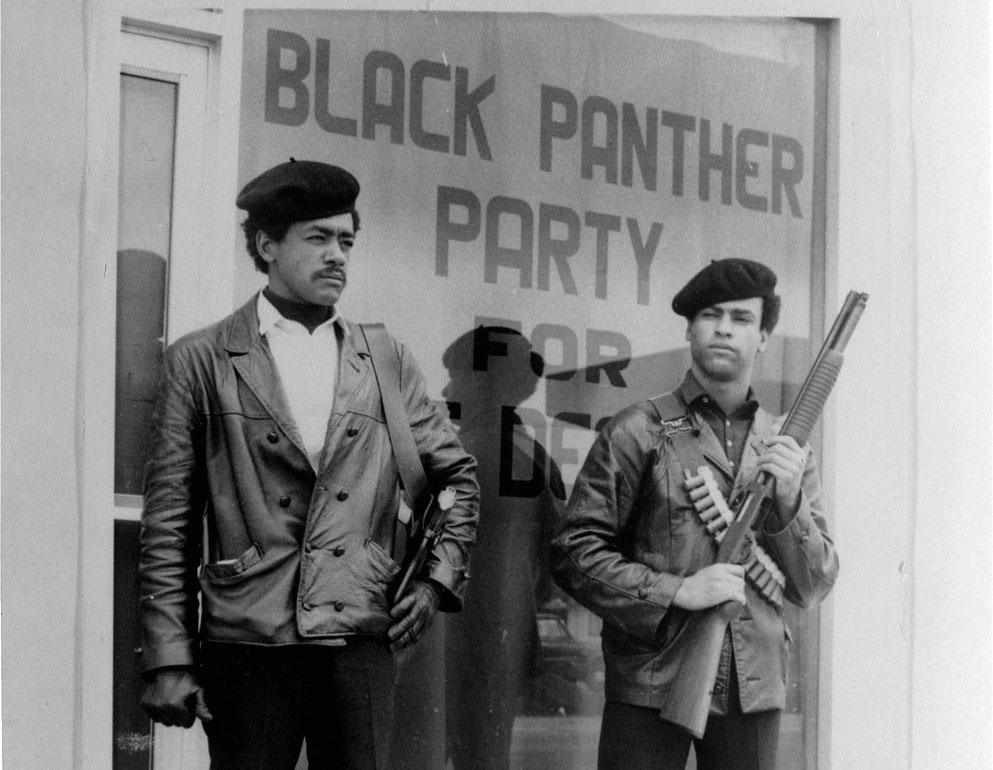The #BlackLivesMatter movement clearly shows that, despite the civil rights struggles of the past, inequality and racism are still thriving in America. Many young people in particular are looking for answers and a way to solve the problems facing society. As Marxists we stand on the front lines in the struggle against discrimination in all its forms. We believe that to be successful, this must be combined with the united working class’s struggle against capitalism and for socialism. We take this opportunity to look back at and learn from the successes and failures of one of the most inspiring experiences of our movement.
Fifty years have passed since the assassination of Malcolm X on February 21, 1965. Three years after Malcolm’s murder, on April 4, 1968, Martin Luther King Jr. was also felled by an assassin’s bullet. The true political trajectory of these two great leaders has been obscured by those who would caricature and vitiate their legacy. The revolutionary strivings of their final years have been buried beneath a mountain of calumnies and hypocritical paeans to their greatness. As Lenin explained in State and Revolution in relation to the treatment of Marx’s ideas by the reformists:
“What is now happening . . . has, in the course of history, happened repeatedly to the theories of revolutionary thinkers and leaders of oppressed classes fighting for emancipation. During the lifetime of great revolutionaries, the oppressing classes constantly hounded them, received their theories with the most savage malice, the most furious hatred and the most unscrupulous campaigns of lies and slander. After their death, attempts are made to convert them into harmless icons, to canonize them, so to say, and to hallow their names to a certain extent for the ‘consolation’ of the oppressed classes and with the object of duping the latter, while at the same time robbing the revolutionary theory of its substance, blunting its revolutionary edge and vulgarizing it.”
Between the bloody bookends of Malcolm and Martin’s murders, in October 1966, the Black Panther Party for Self-Defense was founded. The years before and after were a turbulent period, with the postwar economic boom peaking then waning, the deindustrialization of the country creeping, the Vietnam War and the protests against it raging, and political assassinations following one upon another, all against a backdrop of widening social polarization. In the neglected and brutalized inner cities, black Americans threw themselves into the vortex of struggle, their sights sharply trained on the institutional racism of the system, defiantly resisting all attempts to subjugate and trample the very dignity of those most blatantly exploited and oppressed.
Read also: On the Program of the Black Panther Party: Which Way Forward for Black Workers and Youth? - Part one and part two
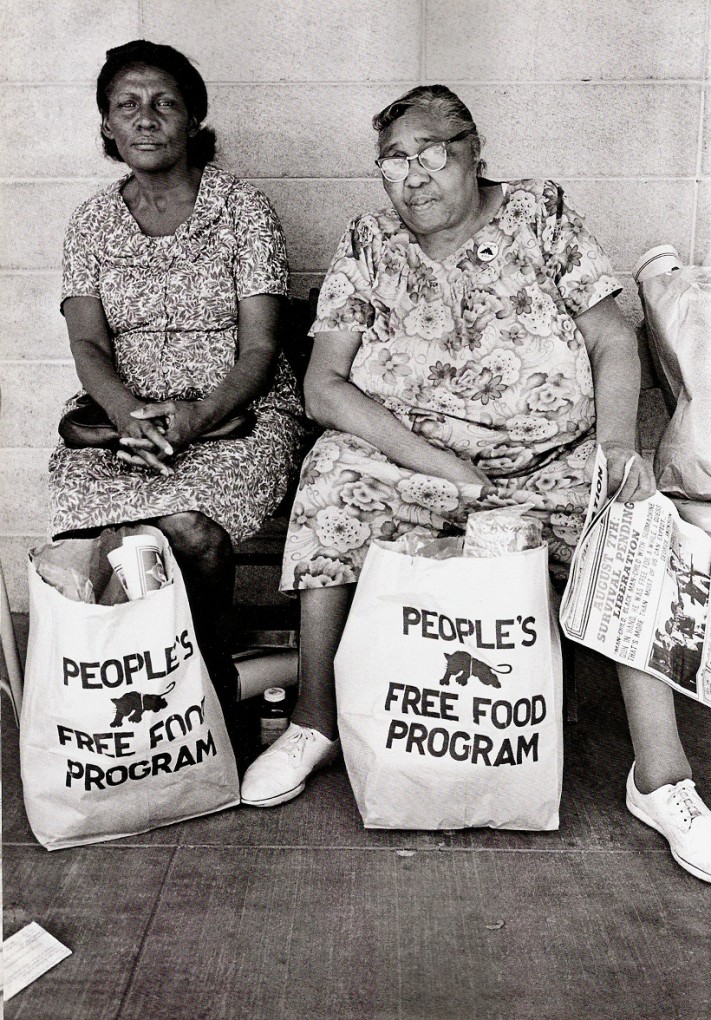 The struggle took many forms: from pacifist sit-ins to militant confrontation; from mass demonstrations to ambushes of the police; from student occupations to the murder of incompetent and reactionary officers by soldiers in Vietnam; from literacy and breakfast programs to lobbying and political campaigning. The depths of the black population were stirred to action. Union organizers, college students, veterans, housewives, Baptist congregations, Black Muslims, and even street gangs joined the fray. Demands with a clear class content were raised, including: “Jobs for All Now!” and “For Full Employment!” A tornado of ideas—and not a small amount of confusion—affected and infected people’s minds: Stalinism, Maoism, Guevaraism, Black Nationalism, anti-imperialism, third-worldism, studentism, workerism, New Age-ism, and myriad other variations. The revolutionary ferment was also expressed in a vibrant explosion of art and culture in all its forms, from music, theater, dance, and poetry to cinema and street art.
The struggle took many forms: from pacifist sit-ins to militant confrontation; from mass demonstrations to ambushes of the police; from student occupations to the murder of incompetent and reactionary officers by soldiers in Vietnam; from literacy and breakfast programs to lobbying and political campaigning. The depths of the black population were stirred to action. Union organizers, college students, veterans, housewives, Baptist congregations, Black Muslims, and even street gangs joined the fray. Demands with a clear class content were raised, including: “Jobs for All Now!” and “For Full Employment!” A tornado of ideas—and not a small amount of confusion—affected and infected people’s minds: Stalinism, Maoism, Guevaraism, Black Nationalism, anti-imperialism, third-worldism, studentism, workerism, New Age-ism, and myriad other variations. The revolutionary ferment was also expressed in a vibrant explosion of art and culture in all its forms, from music, theater, dance, and poetry to cinema and street art.
But this colossal outpouring of energy failed to transform society at its root. Capitalism was eventually given another lease on life. As a result, the rot of racism remains a festering and debilitating sore on the collective body of the working class to this day. Without the necessary revolutionary leadership and organization, without the ideas, methods, perspectives, and political clarity of Marxism, the frenetic energy eventually dissipated. Capitalism was stabilized and freed up to continue its profit-making debauchery. The ‘60s bled into the ‘70s and then into the ‘80s, and so began the protracted decline of US labor and the many social movements that had shaken the ruling class to its foundations in those years of storm and stress. Black workers were among the hardest hit as the postwar boom ended and huge swathes of industry were dismantled.
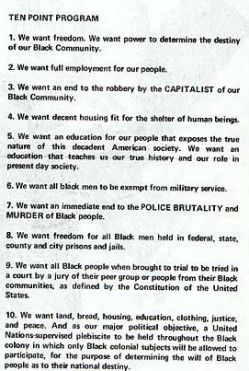 For those who wish to learn from this epoch, there is perhaps no experience more worth examining than the rise and fall of the Black Panther Party (BPP). From a tiny handful of activists in Oakland, California, it grew to national and international prominence, electrifying millions around the world. The strengths and weaknesses of the BPP’s program have been dealt with in detail elsewhere. In this article we will focus on the party’s meteoric rise and precipitous collapse, and the lessons that can be drawn from this.
For those who wish to learn from this epoch, there is perhaps no experience more worth examining than the rise and fall of the Black Panther Party (BPP). From a tiny handful of activists in Oakland, California, it grew to national and international prominence, electrifying millions around the world. The strengths and weaknesses of the BPP’s program have been dealt with in detail elsewhere. In this article we will focus on the party’s meteoric rise and precipitous collapse, and the lessons that can be drawn from this.
What, then, were the economic, social, and political conditions that led to the rise of the Black Panthers—and to their rapid decline? Why didn’t the labor movement and the broader left fill the vacuum? Why weren’t the Black Panthers’ efforts sufficient to eradicate capitalism and imperialism from the planet? What tactics and methods can allow us to achieve socialism?
As revolutionary Marxists committed to the struggle for socialism, our task is neither to whitewash nor to glorify the historical experience of our class. Rather, we must seek to disentangle the dialectical dynamics of any phenomenon, identify what is essential and what is not, comprehend its inner motor forces, and thereby arrive at a deeper, more balanced and nuanced understanding. It is in this spirit that we will survey the life and death of the BPP and its leaders.
The civil rights movement
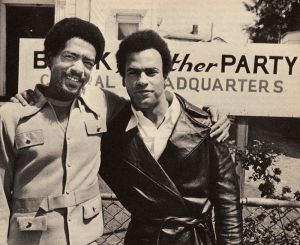 The rise, development, and trajectory of the Black Panther Party cannot be abstracted from the broader historical context and conditions in which it emerged and expanded. The late 1960s and early 1970s witnessed a broad radicalization of the youth. Opposition to the Vietnam War reached a crescendo, with marches on Washington and campus occupations. Internationally, revolution was brewing in France, Czechoslovakia, and Pakistan, and a mass student movement and massacre took place in Mexico.
The rise, development, and trajectory of the Black Panther Party cannot be abstracted from the broader historical context and conditions in which it emerged and expanded. The late 1960s and early 1970s witnessed a broad radicalization of the youth. Opposition to the Vietnam War reached a crescendo, with marches on Washington and campus occupations. Internationally, revolution was brewing in France, Czechoslovakia, and Pakistan, and a mass student movement and massacre took place in Mexico.
The colonial revolution was raging in Africa and Asia, and guerrilla wars were tearing apart Latin America. Massive Stalinist and Maoist organizations spread political disorientation on a worldwide scale. Students for a Democratic Society (SDS) emerged as a conduit for anger on the campuses. The New Left sowed confusion upon confusion in the whirlwind of ideas already crowding the minds of the youth. Polarization in the US was punctuated by violent police attacks on protesters and so-called “race riots” in cities throughout the country.
Despite this turmoil, the BPP was formed at the tail-end of the broader civil rights movement, at a time when enormous reserves of energy had already been expended by the black working class masses. The battle to win basic democratic equality was a truly mass mobilization spanning decades. Its roots stretched back to the post–World War I struggles of returning veterans, and the Brotherhood of Sleeping Car Porters (BSCP), the first labor organization led by blacks to be accepted into the American Federation of Labor (AFL). As far back as the 1920s, BSCP leaders C.L. Dellums and A. Philip Randolph were pioneers in the struggle against the racial inequality and segregation that prevailed throughout the South.
Many organizations and movements had been formed and tested in the early part of the 20th century. Leaders and intellectuals such as Booker T. Washington, Marcus Garvey, and W.E.B. DuBois offered a range of solutions, from “pull-yourself-up-by-your-bootstraps” self-help and respectful submission to the status quo, to radical racial separatism and the “Back to Africa” movement, pan-Africanism, militant integrationism, and even socialism. The great battles marking the rise of the Congress of Industrial Organizations (CIO) shook the South in the 1930s, especially in the textile industry. The seething discontent grew even greater after World War II, when new waves of veterans returned, adamant that they would no longer accept “second-class citizenship,” and demanding jobs for all.
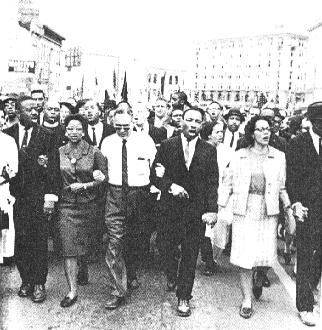 During the war, the second “Great Migration” of blacks out of the South to the industrial centers of the North, Midwest, and West had begun. Millions of people streamed out of the Jim Crow South in search of a better life for themselves and their children, only to find similar hostility and discrimination in their new homes. From the National Guard being called out to enforce integration of public school in Arkansas, to the Montgomery bus boycott and the police dogs and water cannons of Birmingham, what began as a more localized movement in the Deep South eventually consumed the entire country. After many sacrifices, martyrs, trials, and errors, a handful of important, albeit limited democratic rights were wrenched from the ruling class and Jim Crow was dismantled—at least on paper. Many who had participated in those momentous battles settled back into “normal life,” and the flooding river of the class struggle began to recede back into its banks.
During the war, the second “Great Migration” of blacks out of the South to the industrial centers of the North, Midwest, and West had begun. Millions of people streamed out of the Jim Crow South in search of a better life for themselves and their children, only to find similar hostility and discrimination in their new homes. From the National Guard being called out to enforce integration of public school in Arkansas, to the Montgomery bus boycott and the police dogs and water cannons of Birmingham, what began as a more localized movement in the Deep South eventually consumed the entire country. After many sacrifices, martyrs, trials, and errors, a handful of important, albeit limited democratic rights were wrenched from the ruling class and Jim Crow was dismantled—at least on paper. Many who had participated in those momentous battles settled back into “normal life,” and the flooding river of the class struggle began to recede back into its banks.
In the course of the civil rights movement, organizations like the Student Nonviolent Coordinating Committee (SNCC) had been formed. Essentially the youth wing of Martin Luther King Jr.’s organization, the Southern Christian Leadership Conference (SCLC), SNCC played a key role in organizing the “Freedom Rides” and voter registration drives in some of the most right-wing and backwards areas of the South. Hundreds of white and black youth from outside the region, many of them affiliated with the Congress of Racial Equality (CORE), risked their lives to participate in these integrated campaigns. Some of them even lost their lives while defying the local segregation ordinances, refusing to bow to the murderous terror of the Ku Klux Klan in “Mississippi Burning.” SNCC also played a major role in the organization of MLK Jr.’s 1963 “March for Jobs and Freedom” on Washington.
Black Power
However, many of these young activists were increasingly dissatisfied with the pacifist approach of leaders like MLK Jr., the movement’s liberal fellow travelers, and the Democratic Party. In their own way, they were coming to understand that the exploited and the exploiters cannot coexist, that making capitalism a little less onerous by implementing a few reforms here and there is not sufficient. Some of them went on to form the Lowndes County Freedom Organization (LCFO). Armed LCFO activists launched a third-party electoral campaign to challenge both the Democrats and the Republicans, and succeeded in registering 2,500 black voters in the most KKK-dominated county in Alabama. While their electoral campaigns failed, their militant approach resonated with young black activists across the country. As their symbol they had chosen a black panther.
Frustrated, impatient with the lack of immediate results, and looking for a shortcut, SNCC made a major strategic shift in 1966, under the leadership of Stokely Carmichael. Declaring that the way forward was “Black Power”—i.e., political power and self-reliance of, by, and for black people only—SNCC decided to expel its white members. The instinctive resistance of the SNCC rank and file against this undermining of unity was evidenced by the vote totals: 19 in favor, 18 against, and 24 abstentions. But the damage was done.
For decades, black Americans had fought for integration into broader American society, for equal rights, jobs, and opportunity for all. Now, black nationalism and separatism had been revived and injected into a layer of the activist youth. From Alabama this concept spread throughout the country. Many of the expelled white SNCC activists went back to their campuses and formed the nucleus of the anti–Vietnam War movement. However, the broader struggle to collectively change society was deeply undermined.
Founding of the Black Panther Party
The impatience and adventurism of a layer of young activists expressed the growing desperation of the advanced layers, who could sense that the mass movement of the previous decades was subsiding without having fully achieved its stated aims. Among white student activists, the individual terrorism of the Weather Underground, which grew out of SDS, was one eventual expression of this.
Some legislative gains towards racial equality had been made, but jobs, healthcare, education, quality transportation, housing, and infrastructure were far from universally available, and young black Americans were the least likely to have access to them. The battle for genuine equality was far from over. But the left was weak, fragmented, and ideologically confused. The right-wing labor leadership was committed to friendly collaboration with the bosses. As a result, the vacuum of political leadership in the poor, mostly black inner cities was eventually filled by groups like the Black Panther Party.
Inspired by Malcolm X’s call to fight back “by any means necessary,” Huey Newton and Bobby Seale, who studied together at Merritt College in Oakland, California, founded the Black Panther Party for Self-Defense on October 15, 1966. Their choice of name and symbol was a tribute to the LCFO’s work in Alabama. They took the concept of “Black Power” beyond mere electoral politics and believed that “by any means necessary” included taking up arms to defend the lives of blacks being brutalized by the police. As far as they were concerned, it would no longer be “business as usual.” The BPP were not going to let anyone prevent them from being heard.
Shotguns and sunglasses
The party’s program, image, and militancy struck a chord among a layer of black youth, and they grew quickly. The following extract from the trial of a former BPP member gives an indication of what attracted people to them when they first burst on the scene:
Prosecutor: Why did you join the party?
Former BPP member: I thought the Black Panther Party was doing something that needed to be done. They were opposing racism, and I felt that because racism was a problem in the United States that the party was serving the necessary need.
Prosecutor: Why would you have selected the Black Panther Party over certain other organizations which were in existence at the time?
Former BPP member: Well, the other organizations that I knew of had been in existence for quite a while and the problem still existed. The Black Panther Party was new and I thought maybe a new approach might solve the problem.
Prosecutor: Did the Black Panther Party have any approach that you saw at that time which you thought was perhaps going to be more advantageous or beneficial?
Former BPP member: Yes, taking the stance that we were entitled to and have the right of self-defense as opposed to nonviolence.
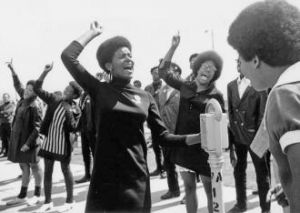 Initially, their focus was the organization of armed citizens' patrols in Oakland to expose, prevent, and—if necessary—fight against the brutality of the “occupying army of the police.” On April 25, 1967, they published the first issue of The Black Panther. On May 2 of that same year, they took things to the next level. In a carefully planned publicity move, they sent 26 armed BPP members in leather jackets, berets, and sunglasses to the state capital of Sacramento to protest legislation that would have restricted the public carrying of loaded firearms.
Initially, their focus was the organization of armed citizens' patrols in Oakland to expose, prevent, and—if necessary—fight against the brutality of the “occupying army of the police.” On April 25, 1967, they published the first issue of The Black Panther. On May 2 of that same year, they took things to the next level. In a carefully planned publicity move, they sent 26 armed BPP members in leather jackets, berets, and sunglasses to the state capital of Sacramento to protest legislation that would have restricted the public carrying of loaded firearms.
Barging past the state police and into the legislative assembly’s chambers, they boldly declared that they required arms to defend themselves against racists. Almost immediately, these “shocking” images of the Panthers were splashed across newspapers and televisions around the world. As the media explained, “Grim faced, and silent, a file of angry young negroes, carrying loaded rifles, trooped into the state capital here in Sacramento.”
BPP founder Huey Newton had come up on the tough streets of Oakland. He was highly intelligent, political, charming, and exuded a larger-than-life presence. But he also had a dark side, and throughout his life had resorted to physical violence to resolve problems. From scuffles with neighborhood kids, to knock-down, drag-out fights with gang members and police, and eventually culminating in accusations of murder, violence followed the BPP’s “Minister of Defense” his entire life.
In October 1967 he was arrested and accused of killing of an Oakland police officer. In response, founding member and editor of The Black Panther, Eldridge Cleaver, launched the “Free Huey” campaign, which would absorb much of the organization’s energy in the years to come. In the course of spreading the campaign, they set up new chapters in cities across the country and forged alliances with other radical organizations such as the Brown Berets, American Indian Movement, Young Puerto Rican Brothers, and the Young Lords.
After Newton was released from jail, there were more altercations with the police. At the same time, he became a celebrity, and was wined and dined by “limousine liberals.” Big donations to the party flooded in from celebrities in Hollywood and New York, and were a big source of funding for party activities. Leonard Bernstein, Marlon Brando, Jane Fonda, Donald Sutherland, Harry Belafonte, Angie Dickinson, and other sympathetic celebrities, who felt that the establishment had to be changed somehow, gave their support. In 1970, Jane Fonda described the BPP as “Our revolutionary vanguard—we must support them with love money propaganda and risk.”
In February 1968, Stokely Carmichael, the former chairman of SNCC, joined the BPP and was appointed the party's “Prime Minister.” As a result, important layers of the party were pulled toward black nationalism. Others were alienated by this new tone and left the party altogether. Under Carmichael’s influence, the party took up slogans such as “White Power for white people! Brown power for brown people! Yellow power for yellow people! Black Power for black people!” While on the surface this may appear eminently “ecumenical” and “democratic,” it was in reality a tragic caving to segregationism and went against the integrationist sentiment of the majority of the black working class. As a minority of the population, black Americans will never be able to fight the capitalist class on their own.
The unity of the working class is in fact its most important strength, and must be ardently defended and nurtured. To willingly divide it along racial, ethnic, religious, gender, or any other lines plays right into the “divide and rule” strategy of the ruling class. If division is somehow good for the exploited and the oppressed, why did the Roman and British Empires, to give only two examples, so zealously pursue this policy during their centuries of successfully subjugating and dominating tens of millions of people?
“Serve the people” and street gangs
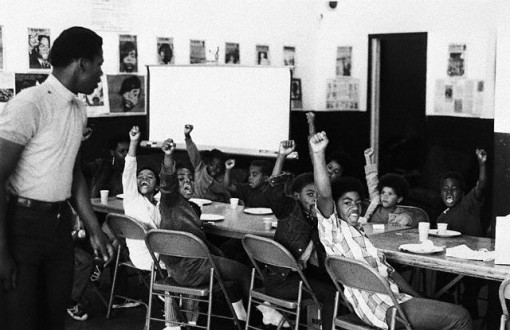 In early 1968, the party sold copies of Mao's Little Red Book to university students in order to buy firearms. Soon thereafter, they made the book required reading and began adopting the Maoist “serve the people” model of political activity. By 1969, social service programs were the core activity of many BPP members, including the Free Breakfast for Children Program, distribution of shoes and clothing, and community health clinics.
In early 1968, the party sold copies of Mao's Little Red Book to university students in order to buy firearms. Soon thereafter, they made the book required reading and began adopting the Maoist “serve the people” model of political activity. By 1969, social service programs were the core activity of many BPP members, including the Free Breakfast for Children Program, distribution of shoes and clothing, and community health clinics.
At first glance, making it the revolutionary party’s purpose to “serve the people” sounds very radical, and feeding hungry children is certainly a laudable objective. However, it is not the primary role of the revolutionary party to provide charity and social services, i.e., to fill the gap left by the bourgeois state. One role the party can play in the course of its activity is to organize the working class and broad layers of the population to demand aid and improved social services from the bourgeois state. However, a revolutionary party can only try to organize the masses if it has a sufficient number of trained cadres.
When a problem hits the working class, such as an earthquake or a long strike causing hunger in the strikers' families, revolutionaries can certainly organize class-based aid, but this is supplementary to the main priority of building the subjective factor. If we concentrate our political activities on charitable work, the list of problems under capitalism will never end, and we will never succeed in building an organization that can lead the working class to transform society and end the need for such charitable work once and for all. Even if the importance of political education is acknowledged in words, in practice this leads to constant, low-level activism and a revolving door of membership.
The key lesson of the Bolshevik Party is that a few simple slogans, good will, and hard work are not enough to bring about the socialist revolution. The essential task of the revolutionary party is to build a cadre organization with roots in every workplace, school, and neighborhood, capable of leading the working class to state and economic power, thereby allowing humanity to collectively use the wealth of society to improve everyone’s quality of life through fundamental structural change. Its unique and indispensable function is to weld together an organization of the most advanced layers of the working class, and through them, connect these ideas to ever-broader layers of the class—the real and only motor force for revolution.
There is no shortcut to the masses. The party must first go through the time-consuming and painstaking process of assembling the first nucleus of theoretically trained cadres. “Serve the people” is ultimately a form of substitutionalism, of attempting to substitute the small forces of the party for the conscious, organized expression of the working class itself. Thus, the political confusion, already present in the original founding program, was compounded further, and the Panthers’ focus on this kind of work did not lead to the building of a tempered core of steeled Marxist cadres.
State repression
The FBI and local police had had their eyes on the Panthers from the beginning. After their march on Sacramento and Huey Newton’s arrest for allegedly shooting a cop, they quickly became public enemy number one.
The political violence in the country was reaching a fevered pitch. After Martin Luther King Jr. was assassinated in April 1968, riots broke out in Washington, D.C., Baltimore, Louisville, Kansas City, Chicago, Detroit, and Wilmington, Delaware. Just days later, 17-year-old Bobby Hutton, who had been the treasurer and first recruit of the BPP, was killed by Oakland police after a 90-minute shootout. He was shot ten times as he ran, unarmed, out of his house, which had been set on fire by the cops to smoke him out. The shootout had begun after Hutton, Eldridge Cleaver, and six others had allegedly ambushed the police in order to “Free Huey.” In June of that same year, Bobby Kennedy was murdered. The violence then spilled over to the Democratic National Convention in Chicago.
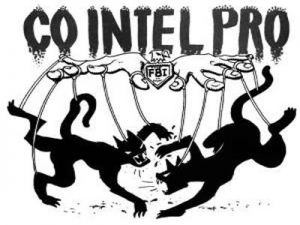 In the midst of this uncontrolled chaos, rabidly anticommunist FBI Director J. Edgar Hoover relished the opportunity to crack down on militant young blacks brandishing firearms and inspiring defiance in poor neighborhoods in every major city in America. He unleashed the full force of the state against the BPP in the form of COINTELPRO, a program started in 1956, the aim of which was to “increase factionalism, cause disruption and win defections” within the Communist Party USA. Much the same approach would be taken as regards the Panthers—with an extra helping of perfidy and brutality.
In the midst of this uncontrolled chaos, rabidly anticommunist FBI Director J. Edgar Hoover relished the opportunity to crack down on militant young blacks brandishing firearms and inspiring defiance in poor neighborhoods in every major city in America. He unleashed the full force of the state against the BPP in the form of COINTELPRO, a program started in 1956, the aim of which was to “increase factionalism, cause disruption and win defections” within the Communist Party USA. Much the same approach would be taken as regards the Panthers—with an extra helping of perfidy and brutality.
After the 1968 presidential elections, in which Mr. “law and order” Richard Nixon was victorious, the FBI sent its local offices a memo calling for “imaginative and hard-hitting counterintelligence measures aimed at crippling the Black Panther Party.” In another memo, it called on agents to “formulate specific counterintelligence techniques to disrupt this nefarious activity." The “nefarious activity” in question were the BPP’s breakfast programs, which the FBI feared were “brainwashing” children with socialist propaganda. The official policy of systematic repression had begun in earnest.
The state’s aim was to terrorize the Black Panthers out of existence and thereby snuff out the aspirations of black workers and youth for a better life. J. Edgar Hoover's infamous September 1968 statement that, “The Black Panther Party, without question, represents the greatest threat to internal security of the country,” was in essence a declaration of “open season” on the party. It sent a message to police that they did not have to concern themselves with legal niceties and “standard operating procedure”—and that law enforcement officers who helped bring down the BPP would would see their career prospects improve dramatically.
The murder of Fred Hampton
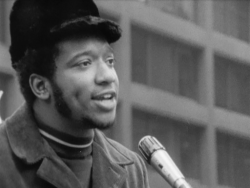 Fred HamptonFred Hampton was one of the most inspiring “natural leaders” to emerge from the Black Panthers. Young and soft-spoken, he was nonetheless a passionate and powerful speaker, with sharp instincts and an organic “feel” for the people. At just 21 years of age, he was chairman of the Illinois chapter and deputy national chairman of the BPP.
Fred HamptonFred Hampton was one of the most inspiring “natural leaders” to emerge from the Black Panthers. Young and soft-spoken, he was nonetheless a passionate and powerful speaker, with sharp instincts and an organic “feel” for the people. At just 21 years of age, he was chairman of the Illinois chapter and deputy national chairman of the BPP.
In a misguided but well-intentioned desire to harness the energy of the disenfranchised youth, the Chicago chapter of the BPP formed an alliance with the Blackstone Rangers street gang. After a shootout on Chicago’s South Side, the Chicago Police Department announced a crackdown on gangs—and included the BPP in their list of targets. Infiltrations of the party were achieved by blackmailing petty criminals along the following lines: “Join the BPP and give us information—and we’ll see about reducing or writing off the charges against you.” By the time Fred Hampton was murdered by the police on December 4, 1969, an FBI informant was the head of security for the Chicago chapter of the Panthers.
On that fateful December night, 9 white and 5 black police officers raided Hampton’s apartment at 4:00 in the morning. Mark Clark, just 17 years old, was sitting in the living room guarding the apartment, and was the first to be shot and killed in the Chicago PD’s hail of bullets. Hampton was shot while asleep in his bed, and his 8-months-pregnant wife was shot alongside him, but survived. After she stumbled out of the room with her hands in the air, she maintains that additional shots were fired in the bedroom where Hampton already lay in a pool of blood, and that she heard a voice say, “he’s good and dead now.”
The police and state officials lied through their teeth to justify and cover up this brazen execution. They initially claimed the Panthers had initiated the shooting. In fact, of 90 bullets fired, only one was fired by the Panthers—by Mark Clark, who probably unwittingly pulled the trigger as his body was riddled with bullets. Although all the survivors in the apartment surrendered peacefully, they were arrested and charged with “attempted murder of the police and aggravated assault.” The charges were eventually dropped, and an out-of-court settlement for $1.8 million was won by the plaintiffs in a subsequent lawsuit for violation of civil rights, though unsurprisingly, no police went to jail for their actions.
At his funeral, spontaneous cries of, “I am Fred Hampton!” swept the crowd of gathered mourners. He had been tried, convicted, and executed by the state, guilty only of inspiring others to fight with pride and dignity for a better future.
Hampton was an incredibly inspiring, passionate, and charismatic figure. Many of the most popular quotes from the BPP’s heyday came from his lips. For example: “We got to face some facts. That the masses are poor, that the masses belong to what you call the lower class, and when I talk about the masses, I'm talking about the white masses, I'm talking about the black masses, and the brown masses, and the yellow masses, too. We've got to face the fact that some people say you fight fire best with fire, but we say you put fire out best with water. We say you don't fight racism with racism. We're gonna fight racism with solidarity. We say you don't fight capitalism with no black capitalism; you fight capitalism with socialism.”
However, like the rest of the BPP leadership, he had an eclectic approach to theory. The result was an often inspiring, but at the same time contradictory mix of black nationalism, anti-capitalism, and socialism.
At first these attacks only served to rally more supporters for the BPP. But given the increasing confusion and chaos prevailing within the organization, it was relatively easy for it to be infiltrated by the FBI and police, who actively used psychological warfare to inject dissension, jealousy, discontent, and further ideological confusion in order to turn party activists against each other. Coupled with selective assassinations of key leaders, co-options, and targeted arrests, the party was steadily weakened. The state’s repression exacerbated processes already embedded in the party, helping to unleash dynamics that would soon spin out of control and lead to its irreversible deterioration.
Peak and degeneration
The lack of a coherent national policy led to rising adventurism and independent initiatives by the many only-loosely affiliated chapters. Violence between party members became increasingly common. In January 1969, there was a gunfight between BPP members at the UCLA campus which left two dead, in an alleged dispute over leadership of a fledgling black studies program. A years-long series of arrests, court cases, murder trials, prison terms, gunfights, ambushes of the police, and assassinations followed. Eldridge Cleaver—who was almost certainly a serial rapist and who was wanted for attempted murder of the police—went into exile with his wife Kathleen to “lay low” and escape prosecution. In the spring of 1970, the Oakland BPP engaged in another ambush of police officers with guns and fragmentation bombs. Two officers were wounded.
Nevertheless, the party continued to grow. By the end of 1969, it had 5,000 members, 45 branches, and their paper had a circulation of 100,000 copies. By September 1970 the BPP reached the zenith of its influence, when 7,000 attended a plenary session of the “Revolutionary People’s Constitutional Convention” in Philadelphia. The plan was to organize a full Constitutional Convention in November of that year, with the aim of bringing together various movements under a common program, including black liberation, antiwar, Puerto Rican independence, student activism, women’s rights, gay rights, labor, and others. Thousands of people descended on Washington, DC, only to find that the authorities had pressured Howard University and other locations not to allow the meetings to be held as planned.
A disorganized series of smaller meetings took place in churches and other smaller venues, but the planned convention fell apart. Huey Newton declared the BPP’s intention to call for a United Nations plebiscite to allow black people to determine what relation they wanted to have with the US government. He also promised a full convention to finalize a new constitution for the movement in the near future. It never materialized. With offices now in 68 cities, a circulation of 250,000 for The Black Panther, and thousands of more or less loosely affiliated members, the party had peaked. Shortly thereafter, its internal contradictions, state repression, and the changed objective conditions pushed it into a rapid and terminal decline.
FBI harassment and split
The FBI began to send forged letters to various leaders with the aim of pushing the already strained relations between different leaders to the breaking point. The party eventually split in March 1971, during a heated, public, live television debate between Huey Newton and Eldridge Cleaver, who had been called in to the show from exile in Algeria. Cleaver was veering towards ultraleftism, advocating the madness of urban guerrillaism, while Newton was slipping toward reformism, advocating that the party give up its arms and work to better the system from within. Cleaver was expelled from the Central Committee and then from the party. He instead formed his own Black Liberation Army paramilitary group.
As a result of this demoralizing disarray, and due to minor concessions by the ruling class on some of the demands made by the movement, including the beginning of the winding down of the war in Vietnam, public support for the party began to plummet. The group was increasingly isolated. Infighting among the party leadership led to further expulsions and defections that decimated the membership. Hundreds of members resigned and “picked sides” in the battle of wills and personalities that ensued. The party increasingly financed its activity through drug dealing, extortion of Oakland small businesses, and robberies of after-hours nightclubs.
The decline continued throughout the 1970s. By 1972, most Panther activity centered on the national headquarters and a school in Oakland. The Southern California branch was shut down and its members moved to Oakland. The underground remnants of the LA branch, which had originally been formed out of the Slausons street gang, eventually descended back into gang activity.
In 1973, the party began to look to electoral politics as a way out of its impasse. Bobby Seale ran for mayor of Oakland and lost, though he received an impressive 40% of the vote. The constant friction and chaos led Huey Newton into a destructive downward spiral of cocaine and heroin addiction. In early 1974, he embarked on a major purge, expelling Bobby and John Seale, David and June Hilliard, Robert Bay, and numerous other leading party members. Dozens of other Panthers loyal to Seale resigned and left the movement altogether.
In August 1974, Newton allegedly murdered Kathleen Smith, a teenage prostitute, and fled to Cuba. Elaine Brown took over the party’s leadership in his absence and dragged it even deeper into the swamp. In 1977, the BPP supported the Democratic Party candidate for mayor, Lionel Wilson, who was successful in his bid to become the first black mayor of Oakland. Their support was given in exchange for Wilson's assistance in having criminal charges dropped against Party member Flores Forbes, the leader of the BPP’s local paramilitary wing, known as the Buddha Samurai Cadre.
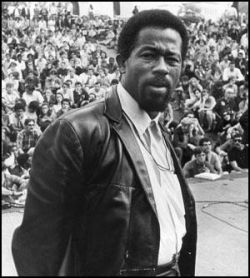 Eldridge CleaverIn 1975, Eldridge Cleaver made a deal with the state and nearly all the charges against him were dropped. He returned from his years abroad as a Moonie, before converting to born-again Christianity and becoming heavily addicted to cocaine. By 1997, a year before his death, he had come to the following conclusion, a far cry from his earlier ultraleft radicalism: “I think that it is possible for the capitalist system to have a program of full employment, but we have a spiritual and moral problem in America. Our problem is not economic or political; it is that we do not care about each other.”
Eldridge CleaverIn 1975, Eldridge Cleaver made a deal with the state and nearly all the charges against him were dropped. He returned from his years abroad as a Moonie, before converting to born-again Christianity and becoming heavily addicted to cocaine. By 1997, a year before his death, he had come to the following conclusion, a far cry from his earlier ultraleft radicalism: “I think that it is possible for the capitalist system to have a program of full employment, but we have a spiritual and moral problem in America. Our problem is not economic or political; it is that we do not care about each other.”
By 1980, the Black Panther Party had just 27 members. In 1982, the last Panther-sponsored school was closed after it was revealed that Newton was embezzling funds from it in order to pay for his drug addiction. Although this marked the formal end to the party’s activities, in reality it had died over a decade earlier. On August 22, 1989, Huey Newton was shot in the head three times in Oakland by Tyrone Robinson, a Black Guerrilla Family gang member. Some claim it was merely a drug deal gone wrong, while others allege there was a contract out on Huey’s life—payback for years of alleged bullying and freeloading.
Other ex-Panthers were hunted down and killed over the years by the police and some went into exile. Eldridge Cleaver ended his days as a right-wing Republican Mormon. Others, such as Marion Barry and Bobby Rush, went into the Democratic Party and carved out nice careers for themselves. Such was the whimpering end of what was once an inspiring beacon of hope for millions around the world—the “greatest threat” to the United States of America. How could things have gone so wrong? What lessons can Marxists today draw from this experience?
The class struggle and the working class
The tragedy of the Black Panther Party is in large part a function of the objective conditions in which it emerged, at a time when the broader movement of black workers to change society was already waning. After the turmoil of the 1950s and early 1960s, a majority of the black workers who had participated in the civil rights movement were just trying to get jobs and to benefit from the postwar boom as best they could. Although very visible, vocal, and militant, the BPP nonetheless represented a relatively small handful of the population, primarily young blacks in the inner cities. They may have been shocking and disruptive to the status quo, but they were not in a position to shut down production, occupy factories, or organize mass demonstrations—the classic methods of mass working class struggle. Added to all this was the party’s eclectic and inconsistent ideology. Without clear and healthy political DNA, even the most self-sacrificing and well-intentioned organizations or individuals cannot hope to grow into a force that can take on the might of the capitalist class and their state.
Within certain limits, comparisons could be made with the Irish Republican Army, the Palestinian Liberation Organization, the Basque nationalist group ETA, and other organizations and movements of that type. In short, despite its initial successes, the Black Panther Party was too small, too ideologically and organizationally unfocused, and above all, too disengaged and disconnected from the broader working class. It represented the unfocused rage of those, who could see the historic opportunity for a fundamental change slipping out of their hands, but who were unsure how to move forward.
We have seen this many times in the history of the working class. After great exertions, defeats, or derailment of a movement into reformism, there is an inward-turning of the class, which can be expressed in all kinds of nihilism, pessimism, superstition, and lack of confidence in the working class and the perspectives for revolution.
It was therefore, in effect, a rearguard action, the heroic efforts of a small group of people who strained might and main to inorganically keep the movement going against all odds, eventually splitting into ultraleft underground urban guerrilla adventurism, on the one hand, and reformist class collaboration on the other. In the end, the leaders were in over their heads, and the party was successfully isolated and susceptible to the state’s machinations, repression, and efforts to co-opt its members.
Marxists take the long view of history and understand that the class struggle invariably passes through periods of upsurge as well as of downturn. If a farsighted and confident leadership is of crucial importance in times of advance of the class struggle, it is perhaps even more important when the movement is being thrown backwards. The task of revolutionaries during periods of retreat is to train and educate the membership, to preserve and painstakingly grow our forces—not to try to force events.
When the boulder of history is at the edge of precipice, even a small force pushing in the right direction can tip it over the edge. But a small organization cannot hold back the boulder once it is rolling in the opposite direction and gaining momentum. It is said that generals who know only how to order a forward march and attack are not of much use. Good generals must also know how to retreat in good order, so that a temporary setback is not transformed into a devastating rout. Unfortunately, given their lack of grounding in the ideas of genuine Marxism, the leaders of the BPP were not equipped to do this.
The large-scale deindustrialization of the country only really set in on a national level during and after the economic crisis of the mid-1970s. But already in the mid-to-late 1960s, many municipalities were already beginning the process, and black workers were usually among the first to be let go. After 1964, the labor movement entered a protracted period of decline, which was further accelerated in the early 1980s. But while the mass civil rights movement had tapered off after having won some of its basic demands, there were still important upsurges of the class struggle that the BPP could have oriented to in a more concerted manner.
Below are just a few examples of important labor struggles from this period (as compiled by Wikipedia):
· 1966 San Francisco Nurses Strike managed by the California Nurses Association
· 1967 Railroad machinists' strike
· 1968 Memphis Sanitation Strike
· 1968 Chrysler wildcat strike
· 1969 Charleston, South Carolina, Hospital Workers' Strike
· 1970 US Postal Service strike, the first US nationwide strike of public employees
· 1970 General Motors Strike
· 1971 Longshore Strike
· 1972 Lordstown Ohio, Auto Workers' Strike
· 1972 Philadelphia Teachers' Strike
· 1974 Washington Bus Strike
· 1974 Baltimore teacher's strike, municipal workers' strike, and police strike
With a class struggle leadership, these mostly defensive battles of the workers could have been united, generalized, and transformed into an offensive industrial and political struggle for a mass party of labor and for socialism. Also during this period, along with urban uprisings in cities such as Detroit, groups such as the League of Revolutionary Black Workers were formed in the auto industry. Had this kind of initiative spread to the rest of the economy and been linked together with the working class as a whole, the subsequent development of the workers’ movement may have been very different. At the very least, a strong cadre organization could have been built and preserved for the battles of the future.
The BPP’s effort to unite the various movements developing in that period shows a healthy and correct instinct, but the number one priority of revolutionaries must always be to connect with the working class and its unions—even when these are dominated by anticommunist, racist, right-wing class collaborationists. Our duty is to break the workers from the influence of such leaders. This is not an easy task in any circumstances, and is even more difficult during a downswing of the broader movement—but there are no shortcuts.
We must patiently explain that the working class can under no circumstances trust or depend on the political parties of the bosses. To effectively fight the bosses and their parties, we require class-independent organizations of our own, under the direct, democratic control of the membership.
Legacy and lessons
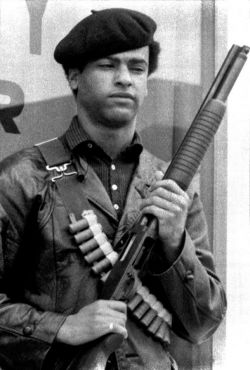 Huey NewtonWithout a doubt, the experience of the Black Panther Party offers us many examples of personal heroism and sacrifice. But if we are objective in our analysis, we must also acknowledge that there are also many examples of “what not to do” when building a revolutionary party. Without clear democratic internal structures, the leadership had a disproportionate say in the direction and policy of the organization. One could even point to a kind of cult of personality around some of its leaders, Huey Newton in particular. The changing whims, shortcomings, and even reactionary aspects of their personalities were transformed into official or unofficial party policy, and shook the confidence of the members and those who might otherwise have become supporters.
Huey NewtonWithout a doubt, the experience of the Black Panther Party offers us many examples of personal heroism and sacrifice. But if we are objective in our analysis, we must also acknowledge that there are also many examples of “what not to do” when building a revolutionary party. Without clear democratic internal structures, the leadership had a disproportionate say in the direction and policy of the organization. One could even point to a kind of cult of personality around some of its leaders, Huey Newton in particular. The changing whims, shortcomings, and even reactionary aspects of their personalities were transformed into official or unofficial party policy, and shook the confidence of the members and those who might otherwise have become supporters.
This leads to an important question: how should a revolutionary party be organized? How can its political cohesion and internal democracy be assured? Should it be a top-down hierarchy, based on clique politics, and loosely federated at the national level? Or is the Bolsheviks’ model of democratic centralism more effective, with discipline based on political conviction, full freedom of discussion to put forward all points of view before a decision is taken by a simple majority vote, followed by unity in action, combined with a centralized, unified national structure? Should its leaders be elected, accountable, and recallable by the membership, or should they be appointed from above? How should disagreements within the party be settled? Through its democratically elected structures, discussion, debate, and votes? Or through cliques, expulsions, and even the assassination of rivals?
Without regular, delegated congresses or conferences debating resolutions, amendments, and other proposals that would affect the policy and perspectives of the organization, the BPP was prone to being crippled and paralyzed by poisonous cliques and interpersonal rivalries, aggravated by police infiltration. As an example, a dramatic change in policy was effected when Stokely Carmichael was appointed “Prime Minister” of the party, alienating many members and injecting a very different ideology into the party from above, resulting in a dysfunctional hybrid of concepts for party members to try and wrap their heads around.
There is also the question of the treatment of women in the organization. Anecdotal evidence would seem to indicate that there was an enormous amount of misogyny within the party, which was not only allowed, but engaged in by the leadership. Apparently, party approval was required for divorces, cheating was condoned, which could only increase interpersonal tensions, and at times, couples were purposely split up. It was clearly not every male or leader of the party who behaved like this, but how can a revolutionary organization possibly forge the necessary class unity between all workers—of all races, ethnicities, and genders—when this kind of behavior is not addressed and dealt with firmly, despite all the nice words about respect for “strong black women,” and so on?
Also, instead of being funded primarily by the dollars and cents of the workers and youth, with an organizational apparatus reflecting their real support in society, the explosive growth in membership and big donations from wealthy celebrities distorted the entire apparatus, leading to a lack of sense of proportion and priorities. When those sources of funding dried up, they turned to crime in order artificially keep things afloat.
And while an effort was made to ensure the political education of the membership, it was confused and inconsistent. Unfortunately, members were presented with a bewildering array of contradictory ideas: from black nationalism and separatism to socialist internationalism; from Stalinism and Maoism to at least some elements of Trotskyism. As indicated by statements such as the following by Fred Hampton—“We have to do more acting and less writing, because people learn through example or participation”—ideas were reduced to a secondary position, instead of understanding the dialectical relationship between ideas and action.
It is not an accident that Marxists insist that mistakes in theory lead inevitably to mistakes in practice. Instead of educating the members in a scientific analysis of what the capitalist state is and how the working class can defeat it and replace it with a democratic workers’ state of its own, the BPP took it head on and inevitably crashed against the rocks.
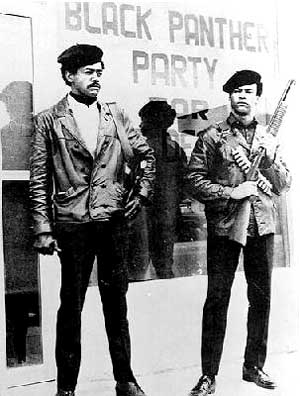 When Marxists refer to the importance of the “armed masses,” it is the “masses” that are key—not the “arms.” The first step is to patiently win the masses. In a revolutionary situation that stirs up the depths of society, arms can be acquired, and the people who know how to use them can be won politically to the side of the majority. Furthermore, for Marxists, the arming of the people is above all a defensive measure, aimed precisely at avoiding violence. It is a case of “preparing for the worst,” with the aim being not having to use them at all. The Bolsheviks fought tooth and nail against the tactic of individual terrorism, including ambushes and murders of individual police officers, which is counterproductive and can only strengthen the state as a whole and isolate the revolutionaries from the masses.
When Marxists refer to the importance of the “armed masses,” it is the “masses” that are key—not the “arms.” The first step is to patiently win the masses. In a revolutionary situation that stirs up the depths of society, arms can be acquired, and the people who know how to use them can be won politically to the side of the majority. Furthermore, for Marxists, the arming of the people is above all a defensive measure, aimed precisely at avoiding violence. It is a case of “preparing for the worst,” with the aim being not having to use them at all. The Bolsheviks fought tooth and nail against the tactic of individual terrorism, including ambushes and murders of individual police officers, which is counterproductive and can only strengthen the state as a whole and isolate the revolutionaries from the masses.
Unfortunately, the BPP ultimately embraced empty, inflammatory slogans such as “the only good pig is a dead pig!” which could only estrange the broader population, who, even if they are not big fans of the police, tend in “normal times” to see themselves as “law-abiding,” and are concerned with issues of crime and criminality. At the same time, they called for “community control of the police,” a utopian and confusing demand, equivalent to pleading with a lion to remove its own teeth and claws.
The true power of the working class, to incapacitate and then remove altogether the old state apparatus, flows from its numbers, unity, and ability to shut down production. Without transportation, communications, food, and other basic necessities, the state has no power to repress the masses indefinitely. An indefinite political general strike of tens of millions of workers is infinitely more difficult to prepare than an ambush of the police by a dozen individuals—but it is also infinitely more effective at actually changing the fundamental functioning of society.
In our article on the program of the BPP we analyzed many more aspects of the party’s strengths and weaknesses, so we need not repeat everything here. Suffice it to say that a sober, Marxist analysis of any historical experience is not about isolating this or that quote, or focusing on this or that individual. Our purpose is to draw an overall balance sheet, with the aim of understanding how the working class can actually end capitalism and build socialism in the next historical period.
The experience of the last 160 years shows that working class cannot improvise a revolutionary party at the last moment. It is an arduous process to select, test, and develop the cadres, program, methods, and traditions. The contradiction we face is that is that we must build now, at a time when the urgency for such an organization isn’t felt as intensely as it will be in the future. Because when that urgency does become apparent, we may not have enough time to pull things together. This is why the Marxists must make the necessary sacrifices now, if we are to be prepared for the future.
Fight for socialism!
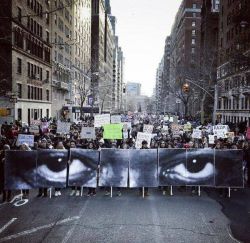 There is no solution within the limits of the profit-driven system of capitalism. The demands first raised decades ago for full employment and genuine equality, are still not a reality. The emergence of #BlackLivesMatter, Occupy, Wisconsin, new unionization drives, the fight for $15—not to mention the revolutionary wave sweeping the world—are a clear indication that we have entered a tumultuous period of resurgence of the class struggle. In Ferguson, Baltimore, McKinney, and beyond, the youth’s instinctive drive for maximum unity is again coming to the fore.
There is no solution within the limits of the profit-driven system of capitalism. The demands first raised decades ago for full employment and genuine equality, are still not a reality. The emergence of #BlackLivesMatter, Occupy, Wisconsin, new unionization drives, the fight for $15—not to mention the revolutionary wave sweeping the world—are a clear indication that we have entered a tumultuous period of resurgence of the class struggle. In Ferguson, Baltimore, McKinney, and beyond, the youth’s instinctive drive for maximum unity is again coming to the fore.
The deep and organic crisis of the system, which can no longer deliver on its promise of the “American Dream” for the majority, is setting the stage for colossal explosions of the class struggle. The streams of struggle are already converging in a way never before seen in the history of the country or the planet. The latest movements are no longer limited to this or that layer of the population struggling more or less independently to improve their position within the framework of capitalism. The compartmentalization of the past has been blown apart by the changed objective conditions, which push people toward collective unity. Millions of youth in particular will no longer stand meekly by as their friends, family, coworkers, classmates, and loved ones are mocked, brutalized, disenfranchised, or otherwise treated like second-class human beings, whether they be female, male, LGBT, black, white, Latino, Arab, Sikh, or any other secondary or tertiary subdivision of the working class. And it is only the beginning.
We therefore agree wholeheartedly that the exploited and the oppressed must fight “by any means necessary” to change society. But experience shows that clear Marxist ideas, combined with mass, socialist, working-class means are what is necessary. At the forefront of this struggle, arm in arm with their class sisters and brothers of all racial and ethnic backgrounds, will be the black workers and youth.
Burying the system that murdered Malcolm X, Martin Luther King Jr., and Fred Hampton is the best tribute we can give these inspiring martyrs of the world working class. To achieve this we must take Bobby Seale’s 1968 exhortation to heart: “We fight racism with solidarity. We do not fight exploitative capitalism with black nationalism. We fight capitalism with basic socialism. And we do not fight imperialism with more imperialism. We fight imperialism with proletarian internationalism.”
Or, as Malcolm X explained, “I believe that there will ultimately be a clash between the oppressed and those who do the oppressing. I believe that there will be a clash between those who want freedom, justice and equality for everyone and those who want to continue the system of exploitation. I believe that there will be that kind of clash, but I don't think it will be based on the color of the skin.”
Due to the historic weakness of the left and the craven class collaboration of the current labor leadership, this will be a drawn-out process. We therefore have some time to clarify the ideas and perspectives, assemble the necessary cadres, and put in place the necessary organizational structures and apparatus—but not all the time in the world. We invite you to join the IMT and the struggle for a better world!

